By Roberto Gallardo, Associate Professor, Agricultural Economics Department, Purdue University
Background
The federal government invests in place-based policies, such as the Economic Development Administration’s Build Back Better Challenge and the National Science Foundation’s Engines program. These place-based policies were inspired, in part, by two diverging economic outcomes in the country. On the one hand, there are thriving regions (e.g., the East and West coasts), while on the other hand, the rest of the country is trying to catch up.
In addition to this divergence, some other demographic trends must also be understood. The St. Louis Federal Reserve Bank examined the age-dependency ratio—this ratio is the number of dependent individuals in specific age groups (ages 0 to 14 years and 65 or older) to the working population (ages 15 to 64 years)—and concluded that it negatively affects investment and economic growth through impacts on workforce development.
The COVID-19 pandemic shed a bright light on childcare issues and its impact on workforce and economic development as parents returning to the workforce or the office in the latter part of the pandemic faced a shortage of childcare options. This, in turn, negatively affected economic development.
Another group of dependents in the age dependency ratio are people 65 years old and older. Most individuals within this age group will start retiring or have retired. Akin to childcare, adult working caregivers may need to take leave or drop out of the workforce entirely to care for grandchildren or elderly family members as they grow older, given that elder care is expensive and the number of elder care facilities continues to decline.
In other words, as the fertility rate continues to decline (less children are born) and the baby boomer generation continues to retire, the age-dependency impact will be significant in regions across the country. The oldest of the baby boomer generation will begin turning 80 in 2026—the institutionalization of seniors increases significantly after the age of 80 due to having limitations with activities of daily living (ADL). So, what does the age-dependency ratio in the North Central region look like and what impacts might it have on workforce and economic development?
Data & Methods
To answer this question, we used U.S. Census age group data at the county level and aggregated them to the state, regional, and national levels between the years 2000 and 2022. The North Central Region (NCR) analyzed here represents the Midwest Region as defined by the U.S. Census Bureau and mirrors the twelve-state region served by the North Central Regional Center for Rural Development (NCRCRD). We identified counties as metro (metropolitan), suburban (micropolitan), or rural (noncore) by applying the USDA Economic Research Service (ERS) 2013 Urban Influence codes to all years.
Results
Figures 1-2 show the population raw numbers for the country and the NCR. Overall, the nation’s population grew by 18.1% between 2000 and 2022, with the metro portion growing by one-fifth while the rural portion declined by 1.1% (not shown). For the NCR, its population grew by 6.7%, with its metro portion increasing by 9% while its rural portion declined by 4.1% (not shown). Notice how the NCR has a higher portion of rural or noncore compared to the nation (green bar).
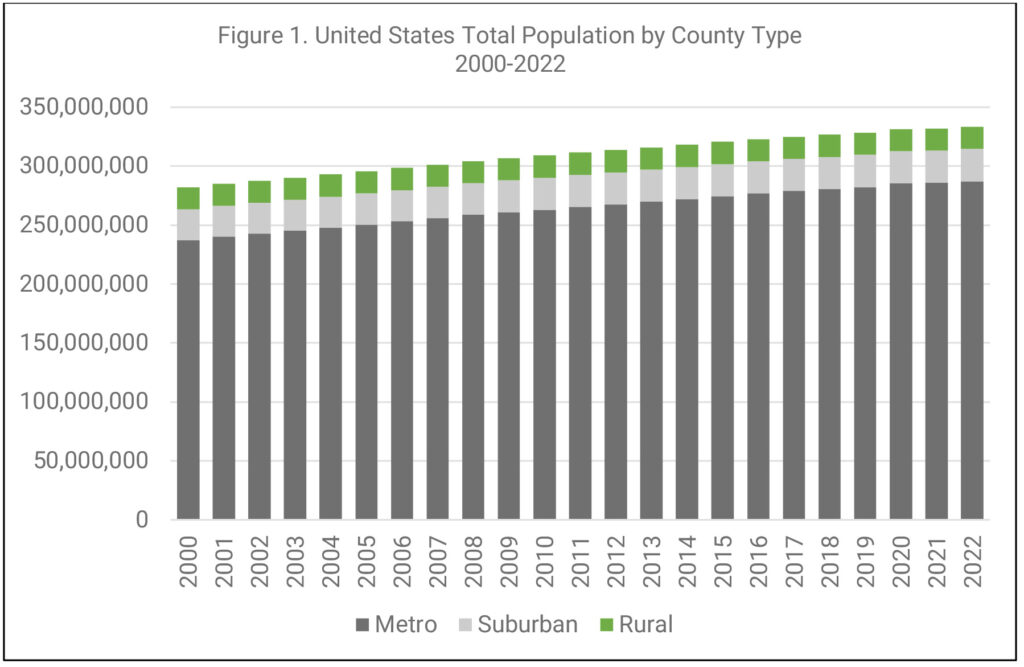
Source: U.S. Census Population Estimates; USDA ERS
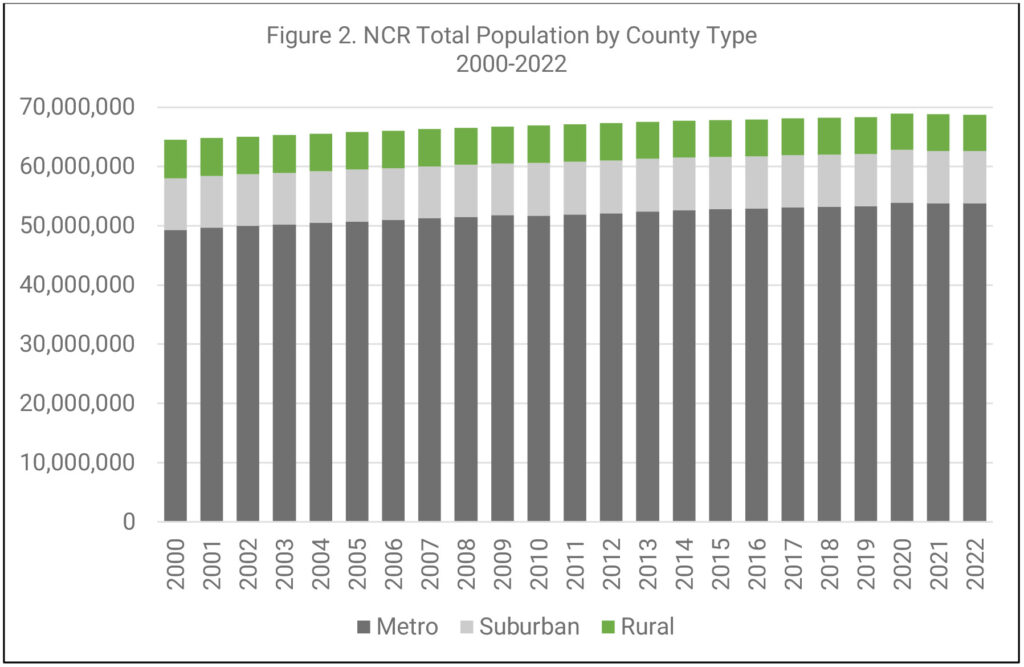
Source: U.S. Census Population Estimates; USDA ERS
Next, we look at each age-dependency ratio component population that includes those ages 0 to 14 years and those ages 65 years or older—raw numbers as the ratios will be discussed later—for the nation and the NCR, as well as its metro, suburban, and rural counties. Figures 3-6 show each age dependency component for the country and its metro, suburban, and rural counties. A couple of insights are worth discussing.
First, note how the child component remained mostly flat (decreasing slightly in the latter years, though more so in rural counties) for the country while the senior component has been steadily increasing. This trend is seen in the metro, suburban, and rural counties as well.
Second, the switch between the share of children and seniors took place at different times over the past 20+ years. For example, the share of seniors outpaced the share of children in rural counties in 2013, followed by metro counties in 2014 and suburban counties until 2018. It is still to switch at the national level. Also, the difference between seniors and children is largest in rural counties, followed by metro and suburban counties.
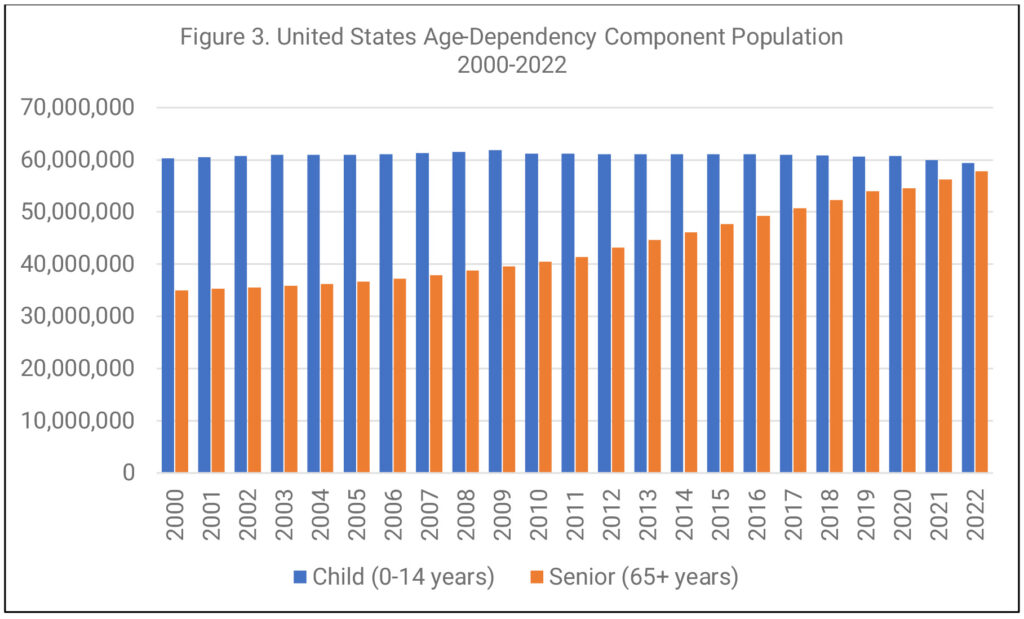
Source: U.S. Census Population Estimates; USDA ERS
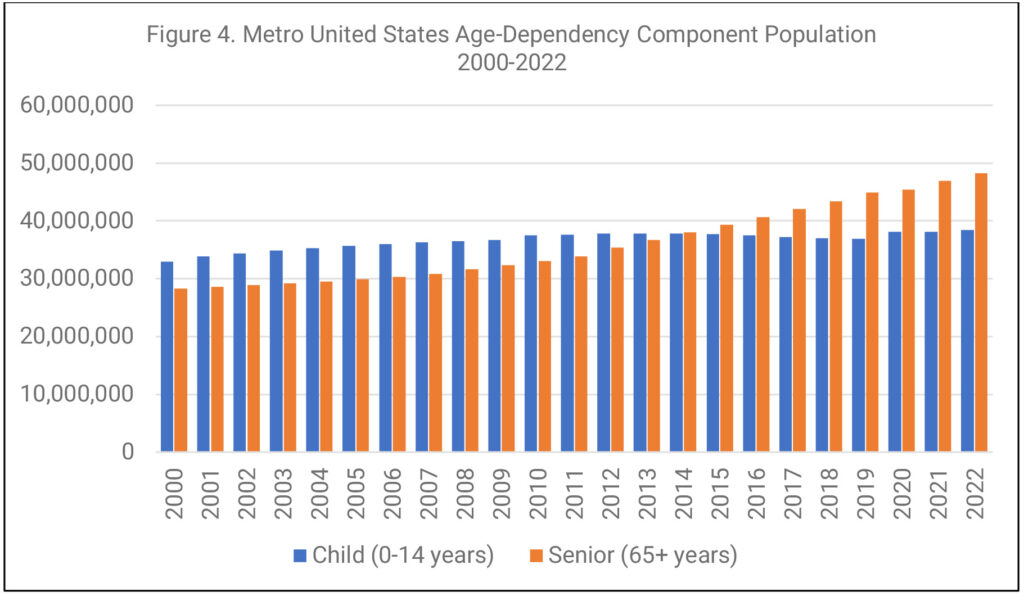
Source: U.S. Census Population Estimates; USDA ERS
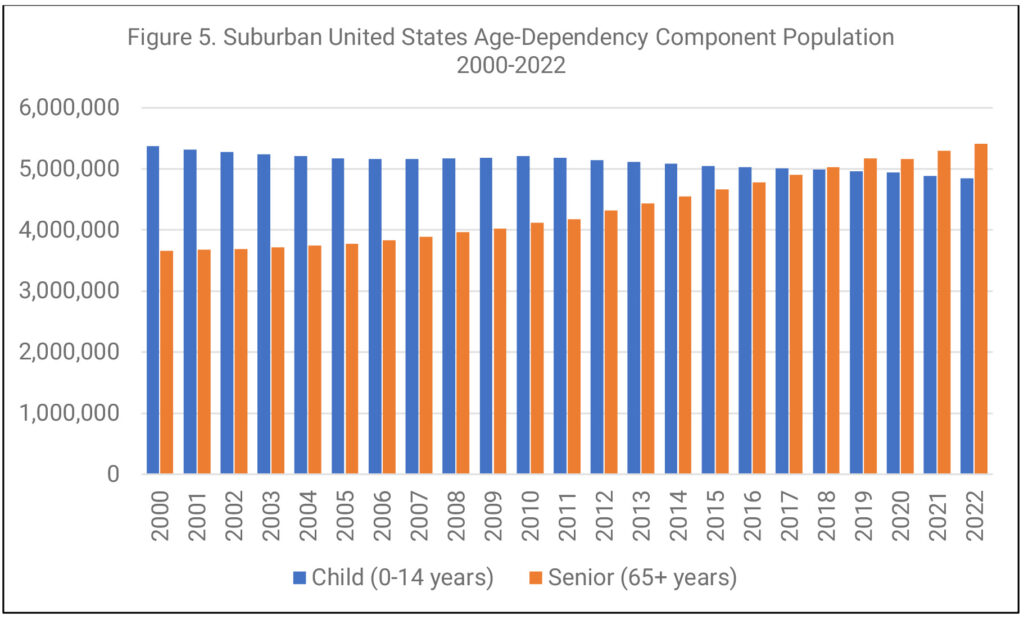
Source: U.S. Census Population Estimates; USDA ERS
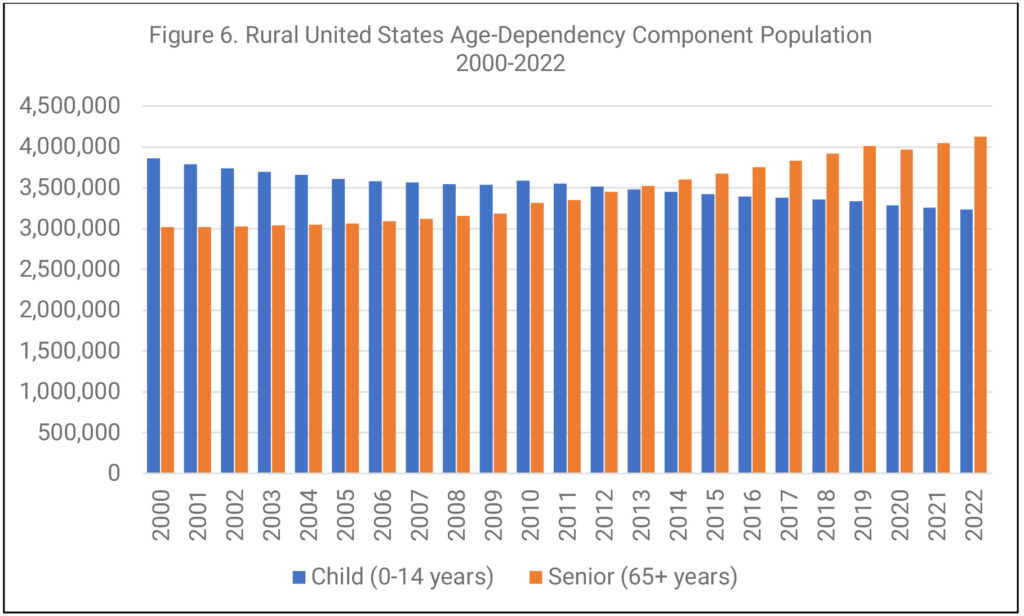
Source: U.S. Census Population Estimates; USDA ERS
Figures 7-10 show the age dependency components for the NCR. Unlike the national trends, the NCR overall and metro counties are yet to “switch.” However, this switch took place a year earlier in rural counties (2012) compared to the nation (2013) and a year later among suburban counties (2019 versus 2018). Again, the difference between the child and senior dependency components was largest among rural counties.
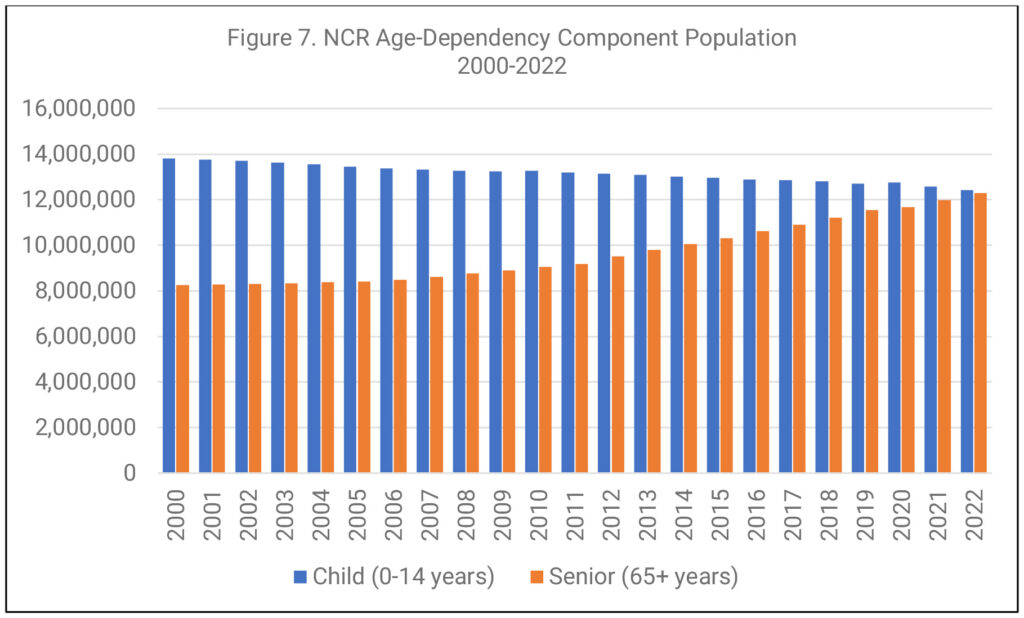
Source: U.S. Census Population Estimates; USDA ERS
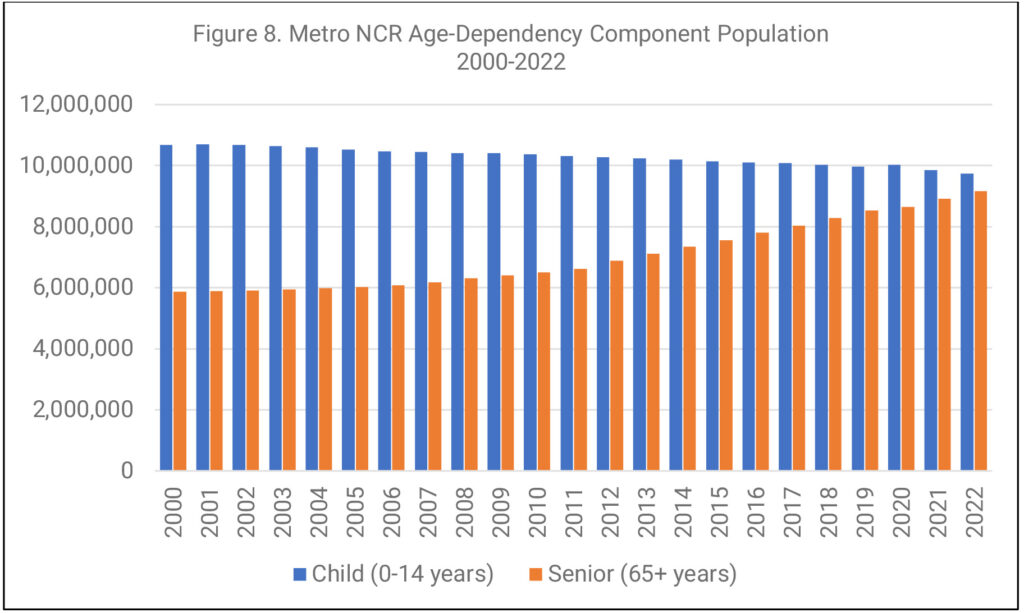
Source: U.S. Census Population Estimates; USDA ERS
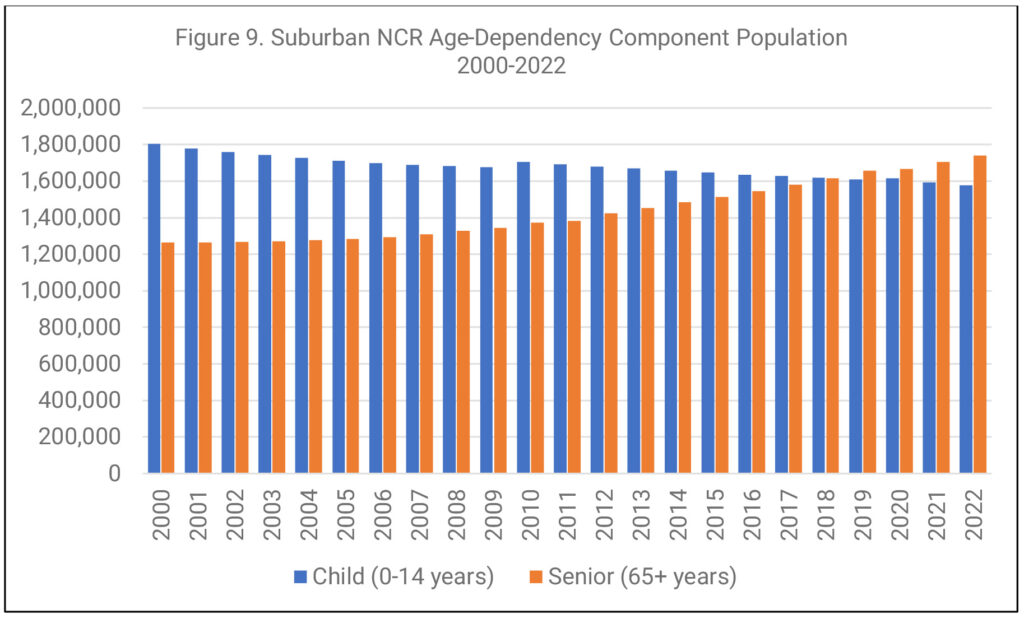
Source: U.S. Census Population Estimates; USDA ERS
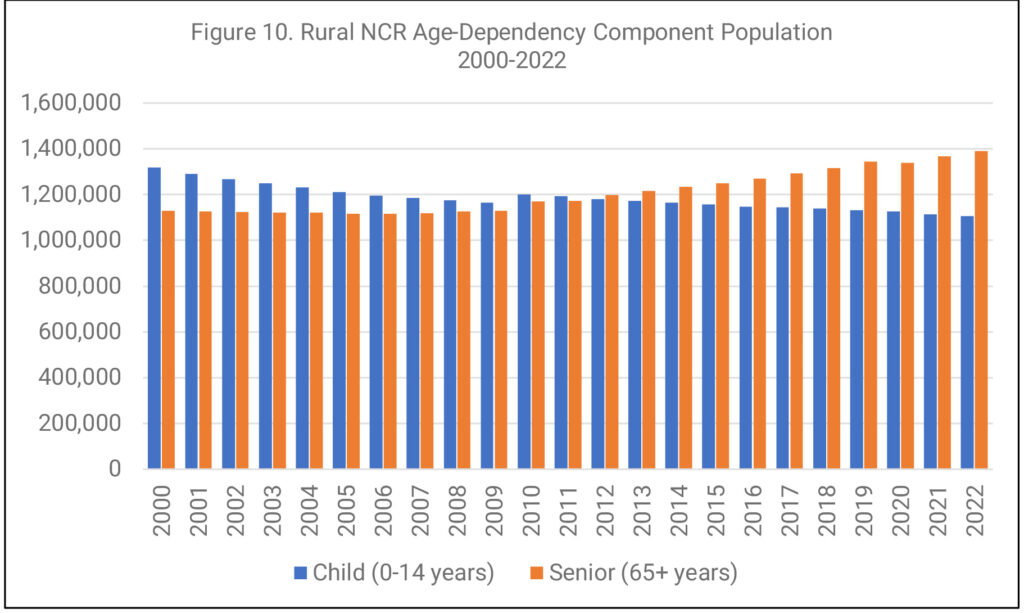
Source: U.S. Census Population Estimates; USDA ERS
Now that we have looked at the raw numbers including population change, children (ages 0-14), working population (ages 15 to 64), and seniors (age 65 or older), we calculate the age-dependency ratios as well as each of its components (child and senior) for the United States and the NCR region as well as the individual states and counties in the region (see interactive tables at the bottom of this report).
Figures 11-14 show the national age dependency ratios by overall, metro, suburban, and rural counties. Notice how the nation’s total age dependency ratio increased from 51 age dependents per 100 workers in 2000 up to 54 in 2022. This increase was driven by the senior component going from 19 to 27 per 100 workers, even though the child ratio decreased from 32 to 28.
A similar pattern happened in metro, suburban, and rural areas of the country. The child component decreased while the senior component increased. The highest age dependency ratio was in rural areas with 65 age dependents per 100 workers in 2022, up from 57 in 2000. The senior component increased 10 points from 22 to 32 in suburban areas and by 12 points in rural areas, from 25 to 37.
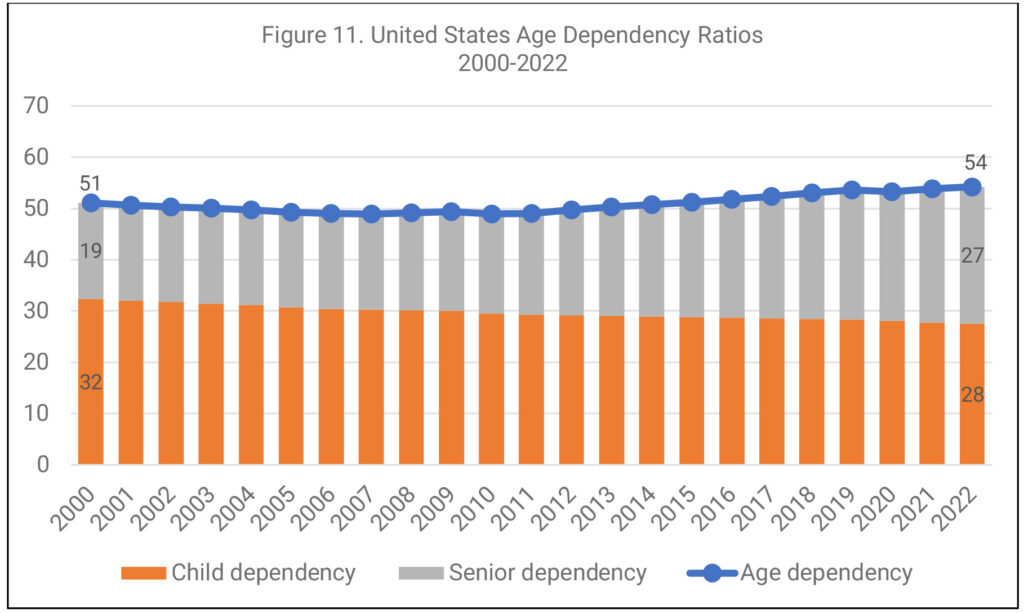
Source: U.S. Census Population Estimates; USDA ERS
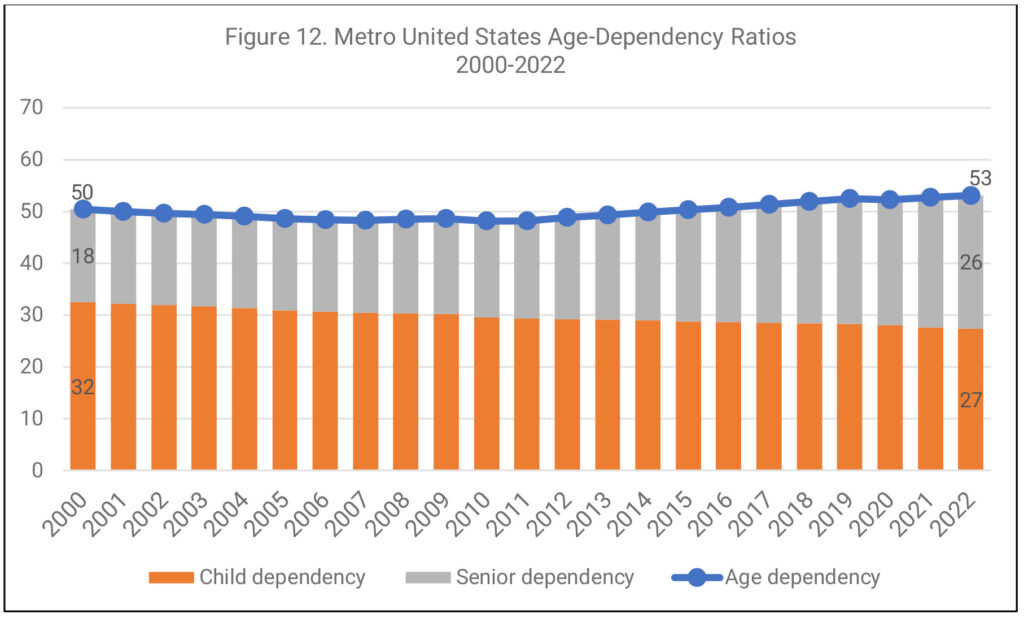
Source: U.S. Census Population Estimates; USDA ERS
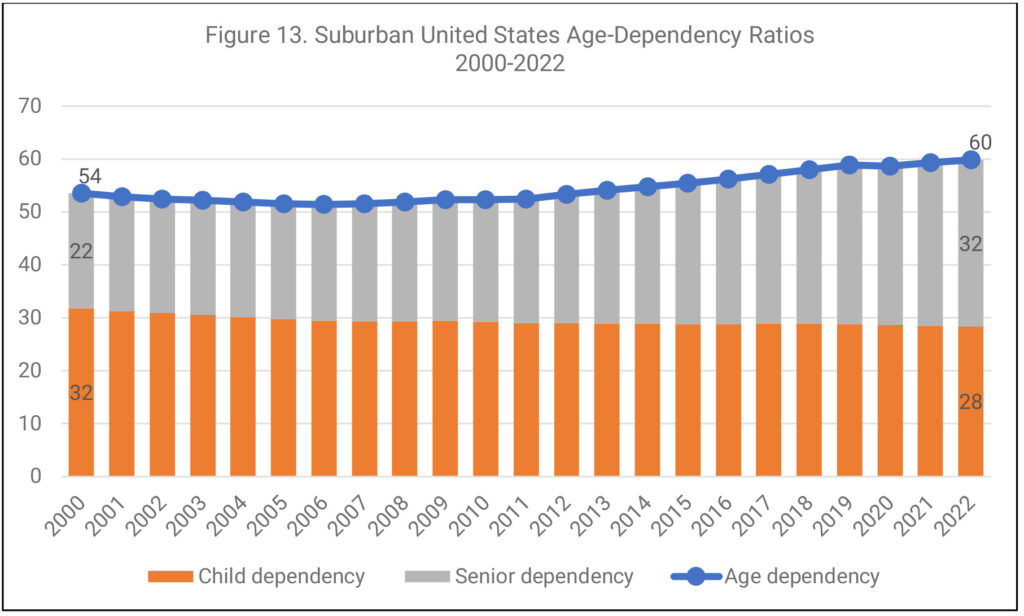
Source: U.S. Census Population Estimates; USDA ERS
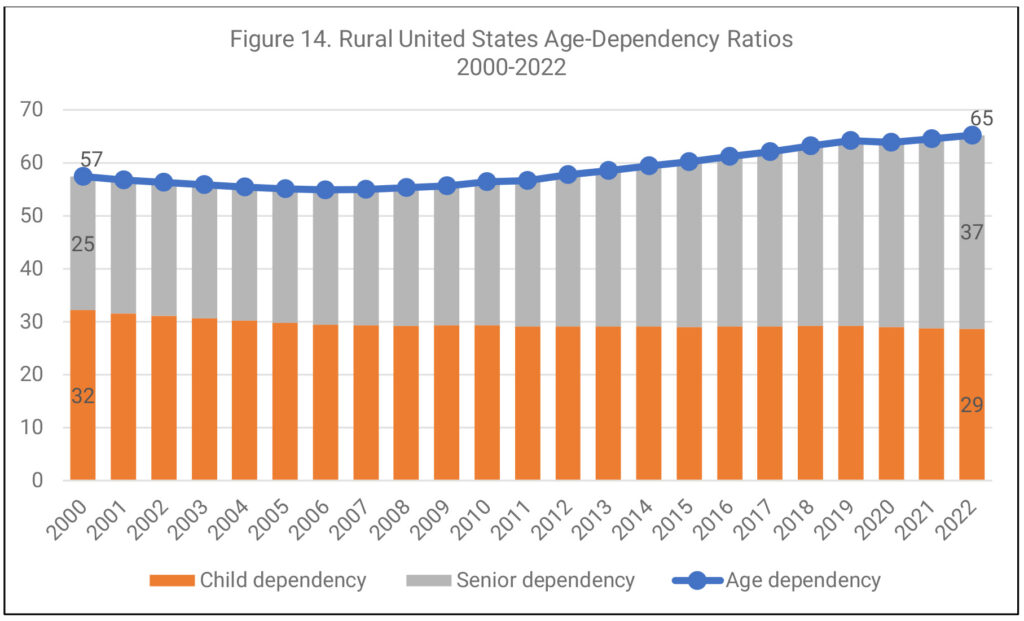
Source: U.S. Census Population Estimates; USDA ERS
Figures 15-18 break down the age dependency components for the NCRCRD region as well as its urban, suburban, and rural areas. A similar trend is seen, although the age dependency ratio is higher in the NCR regions than in the nation. For example, the total age dependency ratio in the NCR was 56 compared to 54 in the nation as of 2022. The difference was larger in rural areas, where rural areas in the NCRCRD had an age dependency ratio of 68 compared to 65 in the nation as of 2022.
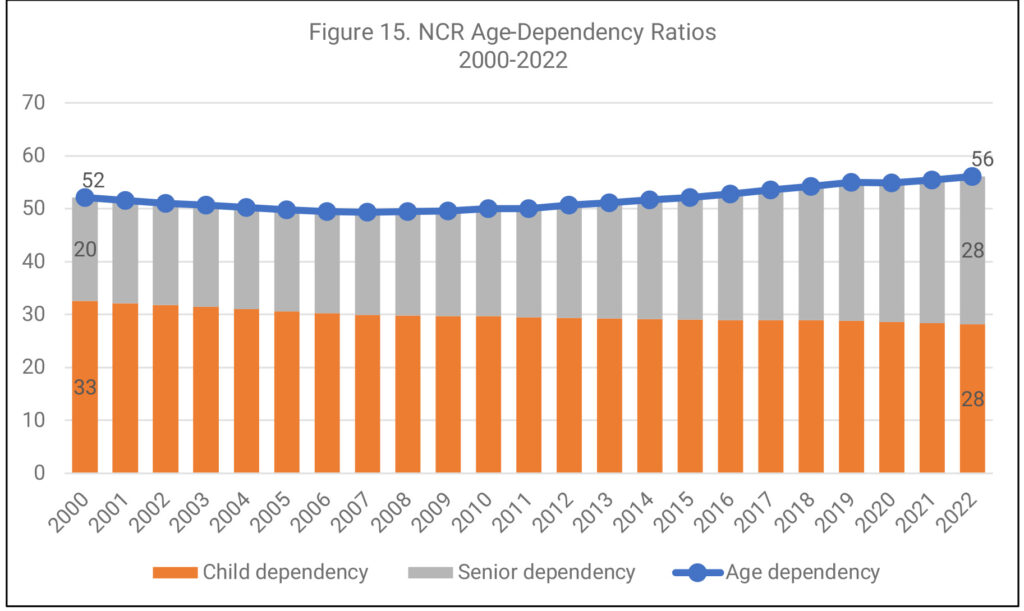
Source: U.S. Census Population Estimates; USDA ERS
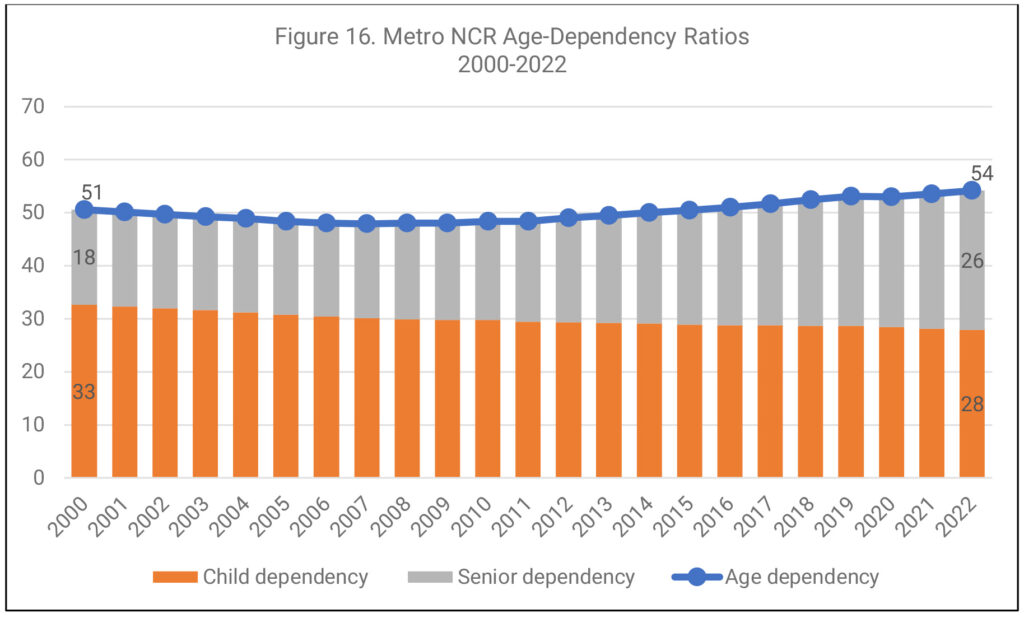
Source: U.S. Census Population Estimates; USDA ERS
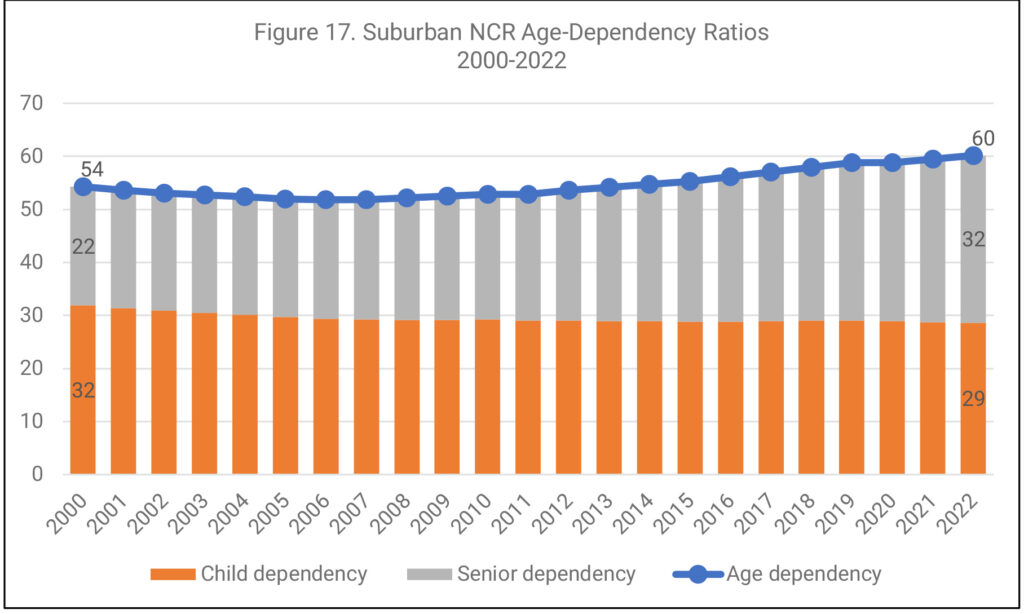
Source: U.S. Census Population Estimates; USDA ERS
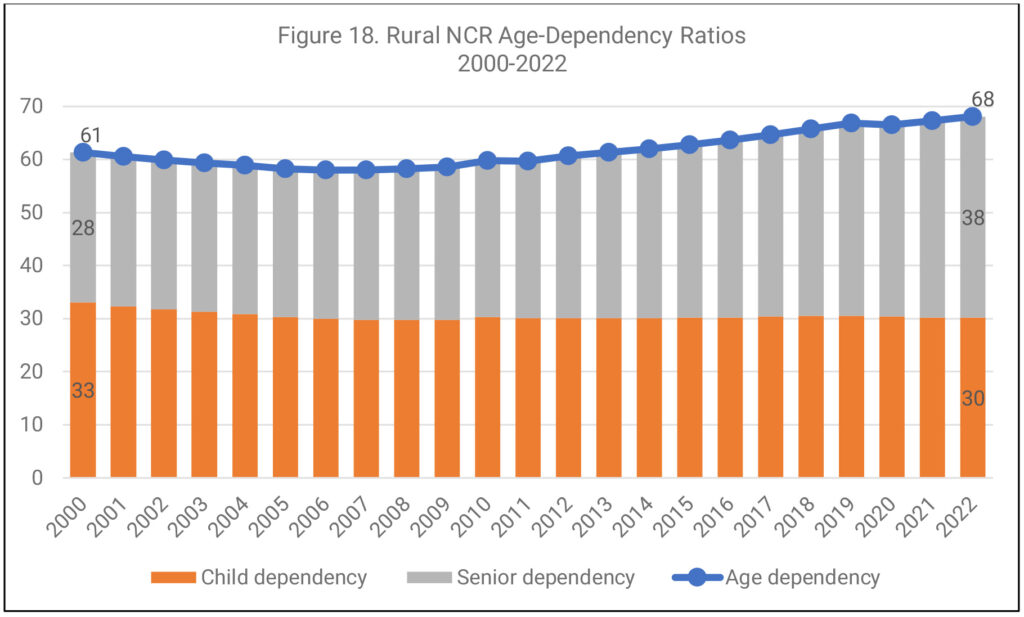
Source: U.S. Census Population Estimates; USDA ERS
Discussion & Conclusions
Significant place-based investments are occurring across the country. These investments will impact the quality of life of these regions by strengthening existing industrial clusters and/or building regional innovation ecosystems or engines with an inclusive focus.
However, as argued throughout this report, some demographic trends (less children being born and a higher portion of residents retiring and growing older) need to be considered because they can undermine these place-based investments and community and economic development overall.
The age dependency ratio is increasing nationwide, but more so in the NCR, particularly its rural areas. The main driver of this increase is the senior dependency ratio since the child dependency ratio declined or did not increase as much. A declining child dependency ratio, while the senior dependency ratio is rising, results in fewer workers or residents in the future.
Communities need to be aware of this issue and start having meaningful discussions on how to address it. One solution could be increasing the supply and affordability of elder care. These facilities are decreasing in number and those remaining are becoming very expensive.
The implications of these findings are wide-ranging, spanning workforce development, caregiving, immigration, education, and health and wellness, to name a few. For example, a study by the Federal Reserve of Chicago looked at what decreases the institutionalization of elders while still providing care and found that as the share of -educated foreign-born immigrants in a particular location increased, the institutionalization of seniors decreased. If communities have a higher share of these immigrants, how can they—more likely women—be trained to conduct this care? Can the creation of elderly care businesses be incentivized and/or subsidized? More importantly, what role can cooperative extension play?
The inclusiveness and diversity implications are significant. Communities that are more welcoming of immigrants and/or inclusive of immigrants, women, and other residents to start businesses and/or provide this care will have a competitive advantage in the years and decades to come without compromising their quality of life.
Two interactive tables are available below. One table lists the national, regional, and age dependency ratios for each of the 12 states in the NCR while the other table lists all counties in the NCR. NCR leaders and residents can search for their state and county and better understand these demographic trends. They can also compare themselves to neighboring counties and perhaps uncover regional trends.
Author
Roberto Gallardo, Ph.D., is Vice President for Engagement, Director of the Purdue Center for Regional Development, and an Associate Professor in the Agricultural Economics Department of Purdue University.
Download article
Suggested citation
Gallardo, R. (2024). The age-dependency ratio in the North Central Region: Implications for regional and community development. Research Brief. North Central Regional Center for Rural Development. https://ncrcrd.ag.purdue.edu/2024/01/18/age-dependency-ratio-in-the-north-central-region/.
